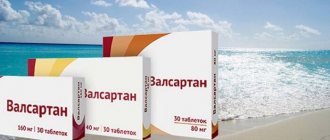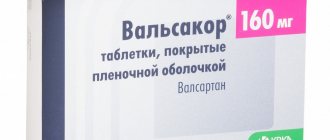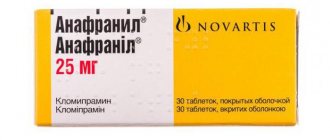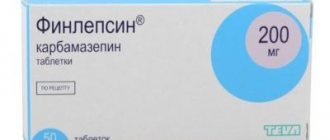Compound
The active ingredient of the drug is imipramine hydrochloride .
Melipramine dragees have the following additional components: titanium dioxide, glycerol 85%, macrogol 35,000, gelatin, talc, lactose monohydrate, red iron oxide, magnesium stearate, sucrose.
Auxiliary components of the solution for intramuscular administration: sodium pyrosulfite, ascorbic acid, sodium chloride , anhydrous sodium sulfite, water for injection.
Additional elements of film-coated tablets: lactose monohydrate, crospovidone, magnesium stearate, povidone K-25. Shell components: hypromellose, dye mixture, magnesium stearate, dimethicone E1049 39%.
Pharmacodynamics and pharmacokinetics
Melipramine is a tricyclic antidepressant. It indiscriminately blocks the reuptake of neurotransmitter monoamines , causing them to accumulate in the synaptic cleft . This leads to increased physiological activity.
The drug also has a thymoleptic effect. It is characterized by concomitant stimulating activity, increases the tone of the body, and provokes a decrease in motor retardation. The medicine has peripheral and central m-anticholinergic , weak antihistamine , myotropic activity .
When taken orally, the drug is characterized by a good degree of absorption from the gastrointestinal tract. Bioavailability can range from 29% to 77%. The maximum plasma concentration is approximately 1-2 hours after ingestion and after half an hour or an hour with intramuscular injections .
The degree of binding to plasma proteins is approximately 85%. The active substance is well distributed in tissues and is able to penetrate the BBB . It also selectively accumulates in the brain, liver and kidneys.
When ingested, it is intensively biotransformed in the liver. Approximately 40% of imipramine hydrochloride is excreted during the day along with urine in the form of metabolites , and 1-2% unchanged. About 20% of the dosage is excreted in bile. The half-life can range from 4 to 24 hours.
pharmachologic effect
Tricyclic antidepressant, dibenzoazepine derivative. Imipramine inhibits the synaptic reuptake of norepinephrine and serotonin released into the synaptic cleft, and thus facilitates noradrenergic and serotonergic transmission of nerve impulses. Imipramine also inhibits m-cholinergic receptors and histamine H2 receptors, and therefore has anticholinergic and moderate sedative effects.
The antidepressant effect of the drug develops gradually. Optimal therapeutic effect may occur after 2-4 (possibly 6-8) weeks of treatment.
Indications for use
Indications for use of the medicine are as follows:
- nocturnal enuresis in children;
- depression and depressive states of various origins, which are accompanied by motor and ideational retardation ;
- obsessive-compulsive disorders;
- panic disorders;
- behavioral disturbances (increased activity or demand for attention);
- chronic pain syndrome;
- narcolepsy combined with catalepsy ;
- frequent headaches ;
- bulimia nervosa;
- withdrawal syndrome ;
- migraine prevention ;
- urinary incontinence.
Reviews
Ilya K .: “The doctor prescribed me melipramine to combat depression and explained how to take it. I followed the instructions strictly and noticed an improvement in about two weeks. I’ve been taking it for a month and a half now, and I haven’t noticed any side effects yet.”
Psychiatrist : “We prescribe melipramine to many patients suffering from severe disorders in the emotional-volitional sphere. The drug is very effective and relatively safe, but it is recommended to start treatment in a hospital because there is a high risk of side effects.”
Content
Contraindications
The drug should not be used for benign prostatic hyperplasia , acute liver and kidney diseases, infectious diseases, diabetes mellitus and heart defects in the stage of decompensation , heart rhythm and conduction , increased convulsive readiness , atony of the bladder , pregnancy (first trimester), breastfeeding , hypersensitivity to tricyclic antidepressants , diseases of the hematopoietic organs, active form of tuberculosis , hyperthyroidism , acute phase of myocardial infarction , severe cardiovascular failure , angle-closure glaucoma , age under 6 years.
This medicine should be used with caution in case of epilepsy .
Side effects
Adverse reactions when using the drug Melipramine may be as follows:
- CVS: tachycardia , orthostatic hypotension , arrhythmia , conduction disturbances ;
- CNS: agitation , headache , paresthesia , convulsions, coordination disorders, hallucinations , phase inversion in the case of bipolar psychosis , dizziness , insomnia , tremor , dysarthria , confusion accommodation disturbances ;
- hematopoietic system: leukocytosis , eosinophilia ;
- allergy : exanthema ;
- Gastrointestinal tract: constipation ;
- urinary and reproductive systems: urinary retention, decreased libido ;
- endocrine system: gynecomastia , galactorrhea ;
- other: dry mouth, photosensitivity, fever , hair loss, increased sweating .
hepatitis , leukopenia , and agranulocytosis develop .
Side effects of the drug Melipramine
The most common side effects of the drug are drowsiness, postural hypotension, tachycardia and atropine-like symptoms: dry mouth, constipation, urinary retention, blurred vision, impaired accommodation, increased body temperature and intraocular pressure. Other less common side effects are neurological:
- headache, peripheral neuropathy, tinnitus, extrapyramidal symptoms (tremor, ataxia, difficulty speaking, especially in the elderly), confusion, delirium;
- epileptogenic effect: primarily in patients with epilepsy or with a tendency to seizures;
- cardiovascular: rarely, mainly after administration of the drug in high doses to especially sensitive patients - arrhythmia, severe hypotension and/or vasospasm, which is manifested by blue discoloration of the fingers;
- gastrointestinal: very rarely - hepatitis with impaired liver function, icterus of the skin and sclera, pain in the liver, metallic taste in the mouth, inflammation of the oral mucosa (stomatitis), nausea, vomiting and in exceptional cases - paralytic ileus;
- allergic skin reactions (14–60 days from the start of treatment): urticaria, angioedema, photosensitivity;
- endocrine: breast enlargement, galactorrhea, complications of diabetes mellitus, decreased glucose tolerance, very rarely - decreased production of antidiuretic hormone;
- sexual disorders - decreased libido, impotence, painful ejaculation, impaired orgasm;
- very rarely, mainly in elderly people, changes in peripheral blood parameters during laboratory tests.
Instructions for use of Melipramine (Method and dosage)
When administering the drug intramuscularly , start with 25 mg 3 times a day. If necessary, the dosage can be gradually increased over the following days. But the daily dose should not be more than 100 mg. After a week of using the medication intramuscularly, the dose is gradually reduced by replacing one injection with a pill or tablet. From the 13th day of therapy, they completely switch to oral administration at a dosage of 25 mg 4 times every day. If symptoms return, you can start taking intramuscular injections .
Instructions for use of Melipramine for the elderly recommend starting therapy with small doses. Usually this is 10 mg/day. Then the amount of the drug is gradually increased to 50 mg. The maximum dosage for older people is 100 mg.
Dragees and tablets are taken orally immediately after meals. Dosages are calculated individually. Typically, for adult patients, the course begins with a dose of 25-50 mg every day 3-4 times. The instructions for use of Melipramine indicate that the daily dosage can be gradually increased by 25 mg and brought to 250-300 mg. The highest doses of the drug for adult patients are as follows:
- single dose – 100 mg;
- daily - 300 mg in hospital or 200 mg on an outpatient basis .
The duration of therapy for mild forms of depression is an average of 5 weeks.
For maintenance therapy, a single dose of medication is recommended in the evening.
For children, the drug is given as an antidepressant at the beginning of the course at a dosage of 10 mg. During 10 days of treatment, it can be gradually increased. For children, the following maximum dosages are indicated:
- age 6-8 years - give 20 mg;
- age 8-14 years - give 25 mg;
- age over 14 years - give 100 mg (in 2 doses).
In case of bedwetting , at the beginning of therapy, take the medicine in the following dosages:
- children 6-8 years old – 25 mg;
- children 9-12 years old – 25-50 mg;
- children over 12 years old – 50-75 mg.
This should be done once a day an hour before bedtime. If urinary incontinence occurs in the early hours of sleep, the dosage can be divided into 2 doses. In this case, the first half is taken in the middle of the day, and the second just before bedtime. If the desired effect is not achieved within a week, the dosage can be increased. The maximum daily dose for children is 2.5 mg/kg.
In case of severe depression in a hospital , the medicine can be used simultaneously intramuscularly and orally . If the drug is taken as an antidepressant , administer up to 100 mg per day in several doses. The highest single dose for adult patients is 50 mg, daily dose is 300 mg.
If you stop taking it too soon, it may cause depression . The medication must be discontinued gradually.
Special instructions for the use of the drug Melipramine
The therapeutic effect of Melipramine develops gradually - over 2-4 weeks from the start of treatment. Therefore, maintenance treatment should be continued for at least 3, sometimes up to 6 months, until a significant improvement in the patient’s condition occurs. The use of Melipramine should be discontinued gradually - sudden discontinuation of therapy can lead to the appearance of symptoms such as nausea, headache, discomfort, anxiety, sleep disturbances, arrhythmia, extrapyramidal symptoms such as speech difficulties, especially in children. Before starting to use Melipramine, it is necessary to determine the functional state of the liver, kidneys, cardiovascular system, blood glucose levels, blood pressure, and hemogram parameters. If electroconvulsive therapy is used, Melipramine should not be administered. When treating with MAO inhibitors, it is necessary to take a break of 3-4 weeks before using Melipramine. This prevents the occurrence of seizures, increased blood pressure or body temperature. When switching after therapy with Melipramine to the use of MAO inhibitors, you should also take a break for several days. During the entire course of treatment with Melipramin, you should not drink alcoholic beverages. If persistent constipation or difficulty urinating during treatment occurs, you should inform your doctor. You must be very careful if epileptic seizures were noted before or during treatment with Melipramin. It is possible that other medications should be prescribed to prevent seizures. Due to the sedative effect of Melipramine, when using it, you should not drive vehicles, operate machinery, or engage in activities that require increased attention.
Overdose
When taking the drug in dosages exceeding the norm, dizziness , ataxia , stupor, mydriasis , arrhythmia , repolarization disorders , arterial hypotension , cyanosis , fever , agitation, convulsions, coma , AV block , sinus tachycardia , collapse with high venous pressure , respiratory depression are possible , vomit.
Treatment includes gastric lavage using saline solution , as well as taking Activated Carbon . It is necessary to constantly monitor the ECG . Slow intravenous administration of F isostigmine salicylate : for adults 1-3 mg, for children in childhood - at an initial dosage of 0.5 mg, it is increased if necessary with monitoring of the function of the cardiovascular system and nervous system to 2 mg. If necessary, F isostigmine is administered every half hour or hour, the dose being selected individually.
If there are appropriate indications, symptomatic treatment with anticonvulsants : Diazepam or short-acting barbiturates . The latter are contraindicated if the patient has recently received MAO inhibitors .
Antishock measures include intravenous injections of plasma replacement solutions , glucocorticoids , and oxygen therapy .
In case of hyperthermia, cold rubdowns are used .
Pharmacokinetics
Suction
After oral administration, imipramine is well absorbed from the gastrointestinal tract. It is actively metabolized during the “first pass” through the liver to form desipramine. Taking the drug with food does not affect its absorption.
Distribution and metabolism
The apparent Vd of imipramine is 10-20 l/kg.
Imipramine and desipramine are significantly bound to plasma proteins (imipramine 60-96%; desipramine 73-92%).
The main metabolite desipramine is formed by demethylation and has pharmacological activity. Plasma concentrations of imipramine and desipramine are characterized by significant individual variability. After administration of the drug 50 mg 3 times a day for 10 days, the Css of imipramine in the blood plasma is 33-85 ng/ml, desipramine - 43-109 ng/ml.
Removal
Impramine is excreted in urine (about 80%) and feces (about 20%), mainly in the form of inactive metabolites. 5-6% of the administered dose of imipramine is excreted in urine and feces - unchanged and in the form of the active metabolite of desipramine. After a single administration, T1/2 of imipramine is about 19 hours (9-28 hours).
Imipramine crosses the placental barrier and is excreted in breast milk.
Pharmacokinetics in special clinical situations
Due to reduced metabolism, plasma concentrations of the drug are usually higher in elderly patients than in younger patients.
After a single administration of the drug, a significant increase in T1/2 of imipramine is possible in elderly patients and in case of overdose.
Interaction
The use of the drug together with MAO inhibitors . This combination can cause excessive agitation, pressure , coma , convulsions, and hyperthermia . An interval of at least 2 weeks must be maintained between taking these medications.
Combination with m-anticholinergics leads to the summation of the anticholinergic effects of drugs.
Interaction with thyroid hormone adrenergic action, which provokes tachyarrhythmia and angina .
Combination with adrenergic agonists increases the likelihood of tachycardia , arterial hypertension and arrhythmia due to inhibition of catecholamine inactivation .
The drug reduces the antihypertensive effect of alpha-blockers and central alpha-adrenergic , as well as the anticonvulsant effect of Phenytoin .
The sedative effect of Melipramine increases under the influence of ethanol and drugs that depress the nervous system. Benzodiazepine derivatives and phenothiazines activate anticholinergic and sedative effects.
The biotransformation of the active substance Melipramine slows down under the influence of inhibitors of microsomal oxidation enzymes . In addition, they increase its half-life, which increases the antidepressant effect and toxicity of the drug.
Drug interactions Melipramine
When using Melipramine, it should be taken into account that:
- atropine and similar drugs increase the incidence of side effects of Melipramine;
- CNS depressants and alcohol enhance the sedative effect of Melipramine; benzodiazepines and weak neuroleptics increase the sedative and anticholinergic effect of Melipramine;
- enzyme stimulants (alcohol, nicotine, meprobamate, barbiturates, antiepileptic drugs) increase the breakdown of imipramine, reduce its level in the blood plasma and thus reduce its antidepressant effect;
- cimetidine, methylphenidate, oral contraceptives, steroids, antipsychotics, selective serotonin uptake inhibitors reduce the breakdown of imipramine and therefore increase its antidepressant effect and toxicity;
- tricyclic antidepressants increase the level of antipsychotic agents in the blood plasma (due to competitive binding by liver enzymes);
- thyroid hormones enhance the antidepressant effect of imipramine;
- Imipramine reduces the hypotensive effect of adrenergic blockers (for example, guanethidine) and α2-adrenergic receptor agonists (clonidine, methyldopa);
- imipramine enhances the pressor effect of sympathomimetics (primarily epinephrine, norepinephrine);
- Anticholinergics (phenothiazine derivatives, antiparkinsonian drugs, antihistamines, atropine, biperiden): the combined use of any of these substances and imipramine may lead to anticholinergic effects, as well as increased side effects (for example, paralytic ileus). Patients receiving this combination therapy require close monitoring and dosage adjustments should be made carefully;
- sympathomimetics (mainly epinephrine, norepinephrine, isoprenaline, ephedrine, phenylephrine): combined use with imipramine can lead to increased effects on the cardiovascular system;
- Quinidine: Concomitant use of this antiarrhythmic drug and tricyclic antidepressants should be avoided. During the period of combined therapy, the risk of cardiac conduction disturbances and arrhythmia increases;
- oral anticoagulants: tricyclic antidepressants may inhibit the catabolism of oral anticoagulants, which may lead to an increase in the half-life of the latter, and as a result, an increased risk of bleeding. It is recommended to monitor prothrombin concentrations during treatment;
- Antidiabetic agents: Changes in blood glucose concentrations may occur during treatment with imipramine. Regular monitoring of blood glucose levels is recommended at the beginning and completion of treatment, as well as during dose titration.
Melipramin's analogs
Level 4 ATC code matches:
Doxepin
Ladisan
Ludiomil
Anafranil
Amitriptyline
The main analogues of Melipramin as psychotropic drug: Ketilept , Anafranil , Tranquesipam . In addition, this drug belongs to the sedatives ; this group also includes Phenobarbital , Vernison , Bromizoval .
Reviews about Melipramine
Reviews of Melipramine on forums indicate that the drug is successfully used to treat depression of various origins, obsessive-compulsive disorders , and panic disorders . Patients report that its effect develops gradually. Effectiveness becomes noticeable after a few weeks.
Reviews for enuresis are also mostly positive. As a rule, the drug in this case is given to children. There are reports of some side effects (mostly nausea or drowsiness ), but those who have taken this drug say that all negative reactions are mild and go away with a decrease in dosage.
Pharmacological properties
The spectrum of effects of melipramine on the human body is very wide. Its main effect is an increase in the concentration of monoamines in the structures of the brain. It is the lack of these substances that is associated with the development of depression, insomnia and increased anxiety. Melipramine blocks the flow of norepinephrine, serotonin and dopamine into neurons, thereby increasing their quantity between neurons where impulse transmission occurs. This effect helps improve mood, normalize sleep and reduce anxiety.
With long-term use, the drug begins to act on the autonomic nervous system as a beta-blocker and m-anticholinergic blocker, thereby reducing cardiac conduction. The same effect underlies the treatment of enuresis and reducing the risk of developing gastric ulcers.
An increase in monoamines in the centers of the brain, among other things, has an analgesic effect. This is due to the affinity of some mediators to opioid receptors. This effect underlies the treatment of pain and cocaine addiction.
Melipramine price, where to buy
The price of Melipramin in tablets is about 380-410 rubles. Tablets also cost about 410 rubles. The price of Melipramine in the form of a solution can be from 380 rubles.
- Online pharmacies in RussiaRussia
- Online pharmacies in UkraineUkraine
ZdravCity
- Melipramine tablets p.p.o.
25 mg 50 pcs Egis RUR 356 order
Pharmacy Dialogue
- Melipramine (tablet p/o 25 mg No. 50)Egis
350 rub. order
show more
Pharmacy24
- Melipramine 25 mg No. 50 tablets ZAT FZ Yegis, Ugorshchina
107 UAH. order








